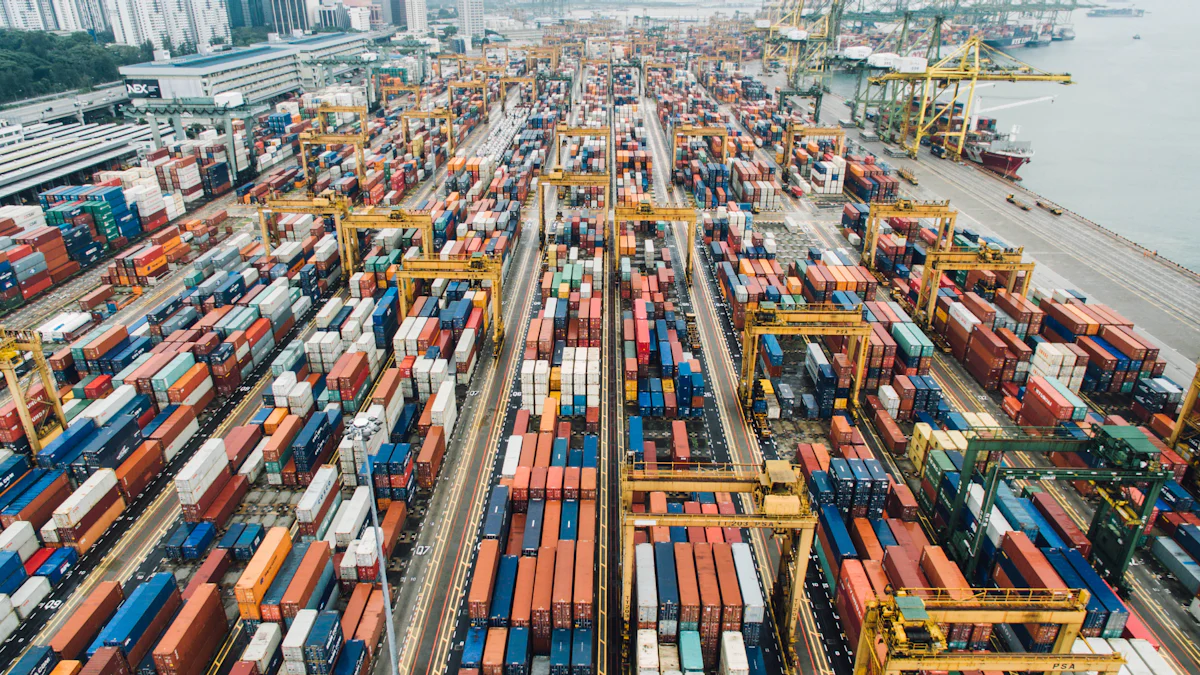Green Logistics Practices: How companies can achieve environmentally friendly supply chains

Sustainable logistics plays a crucial role in reducing the carbon footprint of supply chains. The logistics industry contributes significantly to global carbon emissions, with transportation alone accounting for 23% of CO2 emissions in 2018. Companies face the challenge of addressing these environmental concerns. JUSDA exemplifies leadership in promoting green logistics. JUSDA's innovative solutions help companies transition to more sustainable practices. By adopting these strategies, businesses can not only reduce their environmental impact but also enhance their operational efficiency.
The Necessity for Green Logistics
Current Environmental Challenges
Impact of Traditional Logistics
Traditional logistics practices contribute significantly to environmental degradation. Transportation activities account for a large portion of global carbon emissions. The logistics sector consumes vast amounts of energy, primarily from fossil fuels. This consumption leads to increased greenhouse gas emissions. The use of non-recyclable packaging materials exacerbates waste problems. Companies must recognize the environmental impact of these practices. Adopting sustainable packaging solutions can reduce waste and curb costs.
Rising Consumer Awareness
Consumers now demand more environmentally responsible practices. Awareness of climate change and pollution has increased. People prefer brands that prioritize sustainability. Companies face pressure to adopt green logistics strategies. Meeting consumer expectations can enhance brand loyalty. Sustainable practices can also attract new customers. Businesses must adapt to this shift in consumer behavior. Embracing green logistics can improve competitiveness.
Regulatory Pressures
Government Policies
Governments worldwide enforce stricter environmental regulations. Policies aim to reduce carbon emissions and promote sustainability. Companies must comply with these regulations to avoid penalties. Non-compliance can result in fines and legal issues. Adopting green logistics practices helps meet regulatory requirements. Companies can benefit from incentives for sustainable practices. Governments offer tax breaks and subsidies for eco-friendly initiatives.
Industry Standards
Industry standards increasingly emphasize sustainability. Organizations set benchmarks for environmental performance. Companies must align with these standards to remain competitive. Adhering to industry standards can enhance reputation. Businesses gain recognition as leaders in sustainability. Meeting these standards demonstrates commitment to environmental responsibility. Companies can leverage this commitment to attract partnerships and investments.
Transitioning to Sustainable Logistics

Role of Technology and Innovation
Technology drives the transition to sustainable logistics. Companies use automation to enhance efficiency in supply chains. Automation reduces human error and speeds up processes. Businesses can lower energy consumption through automated systems. Efficient operations lead to reduced carbon emissions.
Renewable energy sources play a vital role in sustainable logistics. Companies invest in solar and wind energy for logistics operations. Renewable energy reduces reliance on fossil fuels. Businesses achieve significant cost savings with renewable energy. The adoption of clean energy enhances brand reputation.
Overcoming Challenges
Cost implications pose a challenge in adopting sustainable logistics. Initial investments in technology and renewable energy can be high. However, companies experience long-term savings from reduced energy costs. Efficient logistics operations lead to decreased operational expenses. Businesses can access government incentives for sustainable practices.
Resistance to change hinders the transition to sustainable logistics. Employees may resist new technologies and practices. Companies must provide training and support for smooth transitions. Clear communication about benefits encourages acceptance. Businesses can foster a culture of sustainability through leadership.
Case Studies:
Vietnam's Manufacturing Sector: Logistics managers and IT specialists in Vietnam highlight technology's impact on green logistics. Companies in the sector use information technology to enhance supply chain sustainability. Regular performance reviews identify areas for improvement in carbon reduction initiatives.
Data-Driven Journey: Businesses measure and reduce carbon footprints through data-driven insights. Companies transition to electric vehicles and reduce mileage. Strategies minimize traffic congestion and avoid idling time.
Sustainable logistics requires commitment and innovation. Companies must embrace technology and renewable energy. Overcoming challenges leads to long-term benefits. Businesses enhance their competitiveness by adopting sustainable logistics practices.
Benefits of Green Logistics Practices
Environmental Benefits
Reduction in Carbon Footprint
Sustainable logistics practices significantly reduce carbon footprints. Companies prioritize optimizing transportation routes to minimize emissions. Data-driven sustainability initiatives play a crucial role in this process. Businesses leverage technology to analyze and improve logistics operations. Route optimization reduces fuel consumption and decreases CO2 emissions. Sustainable packaging practices further contribute to carbon reduction. Companies adopt eco-friendly materials to lower environmental impact. These efforts collectively lead to a more sustainable logistics framework.
Conservation of Resources
Sustainable logistics ensures efficient resource utilization. Companies implement strategies to conserve energy and materials. Renewable energy sources replace traditional fossil fuels in logistics operations. Solar and wind energy power warehouses and transportation fleets. Businesses invest in energy-efficient technologies to reduce waste. Recycling and reusing materials become standard practices. Companies achieve significant resource conservation through these measures. Sustainable logistics promotes a circular economy, benefiting the environment.
Economic and Social Benefits
Cost Savings
Sustainable logistics offers substantial cost savings for businesses. Companies experience reduced transportation costs through optimized routes. Fuel-efficient vehicles and alternative energy sources lower expenses. Data-driven decisions enhance operational efficiency and cut costs. Sustainable packaging reduces material usage and waste disposal costs. Government incentives for eco-friendly practices provide financial benefits. Businesses enjoy long-term savings by adopting sustainable logistics strategies.
Enhanced Brand Image
Sustainable logistics enhances a company's brand image. Consumers increasingly value environmentally responsible brands. Companies that prioritize sustainability attract loyal customers. Green logistics practices demonstrate commitment to environmental responsibility. Businesses gain recognition as leaders in sustainability. Enhanced brand image leads to increased market competitiveness. Companies build trust with stakeholders and investors through sustainable logistics. A strong brand reputation fosters growth and success in the marketplace.
Examples of Successful Implementations

Case Study: JUSDA Supply Chain Management
Strategies Adopted
JUSDA Supply Chain Management stands as a leader in green logistics. JUSDA integrates advanced technologies to enhance sustainability. The company uses big data and IoT for efficient resource management. JUSDA invests in renewable energy sources for logistics operations. The company adopts eco-friendly packaging to reduce waste. JUSDA collaborates with partners to optimize transportation routes. The company implements real-time tracking to minimize emissions.
Outcomes Achieved
JUSDA achieves significant reductions in carbon emissions. The company reports improved operational efficiency. JUSDA experiences cost savings from optimized logistics processes. The company enhances its brand image through sustainable practices. JUSDA attracts new clients who value environmental responsibility. The company receives recognition as an industry leader in sustainability. JUSDA sets a benchmark for other companies to follow.
Industry Comparisons
Automotive Industry
The automotive industry embraces green logistics practices. Companies invest in electric vehicles to reduce emissions. The industry adopts digital platforms for route optimization. Automotive firms use recycled materials for packaging. Companies implement reverse logistics to minimize waste. The industry experiences cost savings from efficient logistics operations. Automotive brands gain consumer trust through sustainable practices.
Electronics Industry
The electronics industry focuses on sustainable supply chains. Companies prioritize renewable energy for manufacturing processes. The industry uses eco-friendly materials to reduce environmental impact. Electronics firms optimize transportation to lower carbon footprints. Companies engage in partnerships to enhance sustainability efforts. The industry benefits from government incentives for green initiatives. Electronics brands improve their market position through responsible practices.
Practical Tips for Implementation
Collaborative Approaches
Partnering with Suppliers
Companies must engage in partnerships with suppliers to achieve sustainable logistics. Collaboration ensures alignment with environmental goals. Suppliers play a crucial role in the supply chain. Businesses should select suppliers committed to sustainability. Joint initiatives can lead to innovative solutions. Companies and suppliers can share resources and expertise. This collaboration enhances efficiency and reduces waste. A strong partnership fosters trust and long-term success.
Engaging Stakeholders
Stakeholder engagement is vital for green logistics. Companies must involve stakeholders in sustainability efforts. Stakeholders include employees, customers, and investors. Communication of environmental goals is essential. Businesses should provide regular updates on progress. Stakeholders appreciate transparency and accountability. Engagement builds support for sustainability initiatives. Companies gain valuable insights from stakeholder feedback. A collaborative approach strengthens relationships and drives change.
Addressing Common Questions
FAQs on Implementation
1. How can companies start implementing green logistics?
Companies should begin with an assessment of current practices. Identification of areas for improvement is crucial. Setting clear sustainability goals guides the process. Businesses can prioritize actions based on impact and feasibility.
2. What are the cost implications of green logistics?
Initial investments may seem high. However, long-term savings outweigh costs. Efficient operations reduce energy consumption. Government incentives further offset expenses.
3. How do companies measure the success of green logistics?
Key performance indicators (KPIs) track progress. Metrics include carbon footprint reduction and resource conservation. Regular reviews ensure alignment with goals.
Solutions to Common Challenges
Resistance to change presents a challenge in green logistics. Companies must address this issue proactively. Training programs can ease the transition for employees. Clear communication of benefits encourages acceptance. Leadership plays a critical role in fostering a culture of sustainability. Businesses should celebrate successes to maintain momentum. Overcoming challenges requires commitment and perseverance. The rewards of sustainable logistics justify the effort.
JUSDA
More than your expectation
Green logistics holds immense importance for businesses today. Companies must adopt sustainable practices to reduce environmental impact and enhance efficiency. JUSDA plays a pivotal role in facilitating sustainable supply chains. JUSDA offers unparalleled supply chain solutions with a strong partnership network. The commitment to sustainability and carbon reduction sets JUSDA apart. Businesses can achieve significant benefits by embracing green logistics. Companies will not only improve operational efficiency but also strengthen brand reputation. Adopting sustainable practices ensures a competitive edge in the global market.
See Also
Maximizing Eco-Friendly Transport in Supply Chain Operations
Transforming Shipping: How Supply Chain Innovation Changes Everything
JUSDA's Role in Advancing Sustainable Supply Chain Practices
